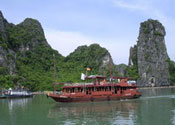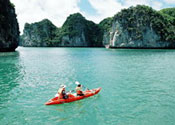|
Halong Bay
 One of Vietnam's most beautiful areas, located about 160 kilometres east of Hanoi, covers an area of 1,553km2, comprising more than 3 thousand beautiful islands of different sizes. Halong Bay was recognized as a UNESCO World Heritage Site since 1994 for its famous valuable natural scenery of limestone and grottoes.. According to legend, the bay's beautiful scenery was carved out by a dragon as he made his flight seawards. The bay is best enjoyed by a leisurely excursion by boat, with stops to explore its fascinating limestone formations, coves for nighttime excursions, sheer cliffs, grottoes, arches and scores of small islets. Halong Bay is a fairylike landscape and has indeed for centuries inspired Vietnamese poets. One of Vietnam's most beautiful areas, located about 160 kilometres east of Hanoi, covers an area of 1,553km2, comprising more than 3 thousand beautiful islands of different sizes. Halong Bay was recognized as a UNESCO World Heritage Site since 1994 for its famous valuable natural scenery of limestone and grottoes.. According to legend, the bay's beautiful scenery was carved out by a dragon as he made his flight seawards. The bay is best enjoyed by a leisurely excursion by boat, with stops to explore its fascinating limestone formations, coves for nighttime excursions, sheer cliffs, grottoes, arches and scores of small islets. Halong Bay is a fairylike landscape and has indeed for centuries inspired Vietnamese poets.
Tuan Chau Island
Located approximately 9km away from Halong City, Tuan Chau is a new wonder to discover as part of Halong Bay Heritage of the World.
The island covers an area of 4km2, comprising 4 hamlets with about 30 houses each. The population live from fishing and agriculture. The inhabitants also started to develop some tourist services.
In Tuan Chau Island, you can see many ancient houses with tiled or thatched roofs, standing under the shadow of trees. A nice guesthouse is situated on the top of the hill, hiding under the trees. This island not only display unspoiled landscapes, but also offers a pure atmosphere. From there one can also enjoy great views of Bai Tho Mountain and Halong.
City in shimmering waters. The beautiful scenery and views of Halong Bay offer great opportunities for taking pictures. You can also walk around the island and go to the fishing wharf to buy fresh sea products. As for drinks, fresh coconut juice is offered by the locals. Several attractive sand beaches are ideal for bathing at any time of the day, or to relax under the shadow of coconut trees.
President Ho Chi Minh once visited the island and compared it to a precious pearl, a gift given by nature. No wonder the friendly local people are very proud of their island.
The romantic Chau Island possesses a great tourism potential and is likely to seduce local as well as foreign tourists.
Thien Cung grotto in Halong Bay
Halong Bay, a UNESCO Heritage of the World since 1994, has always been very attractive for the visitors with its islands, caves and grottoes like Dau Go, Trinh Nu or Bo Nau. But, recently 12 more grottoes were discovered. Thien Cung grotto is one of them and it reveals a world of legends and mystery.
After climbing a short slope, tourists will reach Thien Cung grotto. A big stone dragon hangs from the cave with bright eyes. The skin of its tails is shining with sparkling green pearls. This dragon created by nature a thousand years ago looks even more lively thanks to the artificial light effects. In the grotto, one can also recognize a stone rooster.
Still exploring, you can see a naked girl, her face turned to the wall of the cave, looking ashamed. Legend has it that seven fairies often use to come for bathing in Halong Bay. One day, when it was time for them to fly back to heaven, six of them left with the clothes of the last one. The poor girl had to stay in the cave to hide her nakedness.
Creating its own magic world, Thien Cung grotto’s enchanting beauty appeals to the imagination of the visitors.
Van Don Island
Van Don Island is 50km from Halong City. It is in fact an archipelago comprising 600 islets and covering an area of 584km2. The main two islets are Van Hai and Cai Bau islets.
Cai Rong Town, the major town of Van Don Island, was one of the first prosperous commercial ports under the Ly and Tran dynasties. In the recent years, Van Don has experienced great changes in its economy. Though it is located a bit far away from Halong City, big restaurants have been opening and Van Don receives a great number of visitors. The wharf is lively crowded with ships and fishing boats. Every year, ships catch hundreds of tons of fish, which assures the inhabitant significant revenues and a comfortable life.
Van Don also offers an interesting tourism potential with lovely sandy beaches like Ngoc Vung and other small beaches with blue clear water. Van Don is now studying investment projects from the government and foreign partners to develop tourism and the exploitation of sea products
Quan Lan Island
Quan Lan Island belongs to Bái Tu Long Bay; part of an island range on the outside of the gulf of Bac Bo. It has an area of 11 sq. km, and features eight populated hamlets. Quan Lan Island stretch toward East – West from the foot of Vân Ðon Range to the Gót Mount with many high mountains to the east barring waves and winds, protect the villages. The island is situated on an important navigation route that connects China, Japan, Thailand and Philippines to Vietnam. Along two sides of the island are tens kilometres of sand beaches. This is the endless resource for glass making which the sea gives to man and it is also the extremely interesting tourism
Since the 11th century, Quan Lan had been one of the centres of the ancient commercial port of Vân Don, which was animated and prosperous at the time. Today, there are still many vestiges linked to the ancient commercial port. This also explains why the island, lying deep in the sea, has the large pagodas and archaeological sites seen today. On the island there is the Quan Lan Communal House built in the 18th century; exceedingly beautiful and almost entirely preserved. Next to it is Quan Lan Pagoda (Linh Quang Tu), which is dedicated to Buddha and God Liêu Hanh. The pagoda also worships the statue of old Hau, a local person who made lots of contributions to the construction of the pagoda. The statue features a gentle and cheerful old woman, which adds an original character to the pagoda. Beside Quan Lan Pagoda lies Nghè Quan Lan (Duc Ông) Shrine, which is dedicated to Pham Công Chính, a local people who participated in the historical Vân Don battle against the Yuan invaders. He was later honored as a god. Quan Lan has many valuable sea products such as octopuses, butterfish, mackerel, holothurian, shrimp, and sái sùng.
Wild plants of Ha Long Bay
Located 165km northeast of Hanoi, the archipelago of Ha Long Bay, designated a World Heritage Site in 1994, is one of Vietnam's biggest tourist attractions. But while visitors appreciate the area's stunning scenery, few realize that the bay's jagged limestone islands are home to a wealth of unusual plants, just how many plant species live on these islands remains unknown. Given that Ha Long Bay is dotted with some 2,000 islands, only 900 of which are named, recording the bay's flora is a monumental task.
From April 1999 to July 2000, funding from the Royal Netherlands Embassy in Vietnam allowed Vietnam's branch of the World Conservation Union (IUCN Vietnam) and the Management Department of Ha Long Bay to conduct a series of surveys of the bay's flora. It was this project which took Mrs. Gibbs, Vietnamese botanist Dr. Nguyen Tien Hiep, British botanist Dr. Ruth Kieu, and a team of assistants to the far reaches of Ha Long Bay.
Like Indiana Jones, the team had to be resourceful. "One time, we were climbing an island in very bad weather and desperately wanted to see some cicadas," recalls Mrs. Gibbs. "We'd found so many new species that all of the collecting bags were used up. One of the guys was wearing a waterproof Suit. He took off his waterproof trousers, tied knots in each leg, slung them over his neck and filled up the legs with samples."
This frantic activity paid off. In the course of collecting material for the book, the researchers discovered seven new plant species. They also gathered rare specimens of plants found nowhere else in the world, including the Ha Long Cicada, the lovely Violet Chirita, and the newly discovered Ha Long Fan Palm and White Trumpet Tree. Since the specimens were both rare and perishable, Mrs. Gibbs' who always paints from the living plant, had to work fast. "If it's a plant that's extremely rare I might paint the most fragile part first," she says, adding that the botanists presented her with so many valuable specimens that it was "like lining up casualties outside a hospital tent".
In July 2000 the project published Wild Plants of Ha Long Bay, a book of 30 beautiful color illustrations with text in English and Vietnamese. "This country has a rich biodiversity that can be found nowhere else." says Mrs. Gibbs. "If you can help people to be a little more observant it leads to an appreciation of what's there".
|